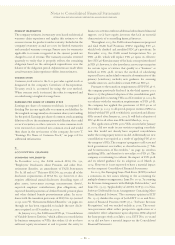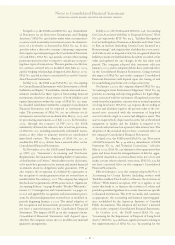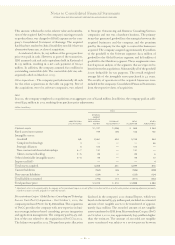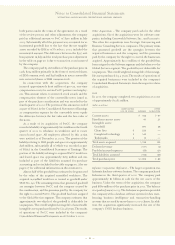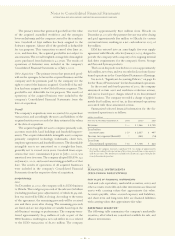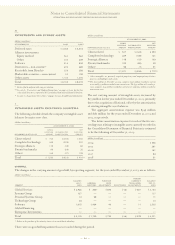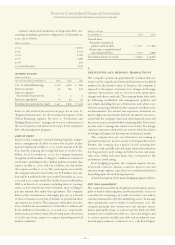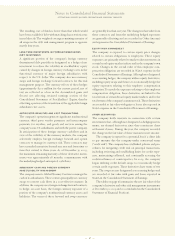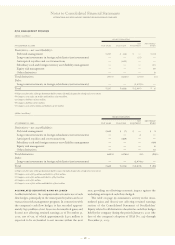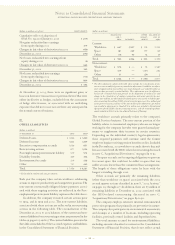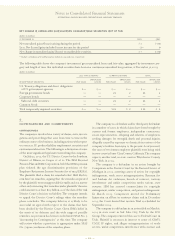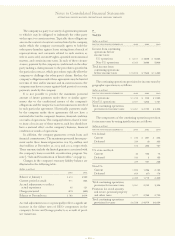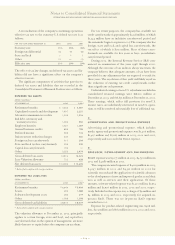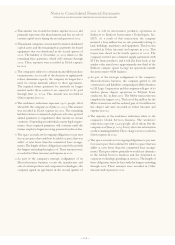IBM 2003 Annual Report Download - page 98
Download and view the complete annual report
Please find page 98 of the 2003 IBM annual report below. You can navigate through the pages in the report by either clicking on the pages listed below, or by using the keyword search tool below to find specific information within the annual report.
Annual contractual maturities on long-term debt out-
standing, including capital lease obligations, at December 31,
2003, are as follows:
(dollars in millions)
2004 $«4,072
2005 3,113
2006 2,760
2007 1,289
2008 225
2009 and beyond 7,942
INTEREST ON DEBT
(dollars in millions)
FOR THE YEAR ENDED DECEMBER 31: 2003 2002 2001
Cost of Global Financing $«503 $«633 $««««964
Interest expense 145 145 234
Interest expense—
discontinued operations —24
Interest capitalized 15 35 33
Total interest paid and accrued $«663 $«815 $«1,235
Refer to the related discussion on page 119 in note X,
“Segment Information,” for the total interest expense of the
Global Financing segment. See note L, “Derivatives and
Hedging Transactions,” on pages 96 to 99 for a discussion of
the use of currency and interest rate swaps in the company’s
debt risk management program.
LINES OF CREDIT
Based on the company’s forward-looking liquidity require-
ments, management decided to renew the 364-day facility,
upon its expiration on May 30, 2003, in the amount of $2 bil-
lion, thereby reducing the total global lines of credit to $10
billion. As of December 31, 2003, the company maintains
two global credit facilities totaling $10.0 billion in committed
credit lines, including an $8.0 billion multiyear facility that
expires on May 31, 2006, and a $2.0 billion, 364-day facility
that expires on May 27, 2004. The total expense recorded by
the company related to the facility was $7.8 million, $9.1 mil-
lion and $7.9 million for the years ended December 31, 2003,
2002 and 2001, respectively. The facility is irrevocable unless
IBM is in breach of covenants, including interest coverage
ratios, or if it commits an event of default, such as failing to
pay any amount due under this agreement. The company
believes that circumstances that might give rise to a breach
of these covenants or an event of default, as specified in these
agreements, are remote. The company’s other lines of credit,
most of which are uncommitted, totaled $8,202 million and
$7,190 million at December 31, 2003 and 2002, respectively.
Interest rates and other terms of borrowing under these lines
of credit vary from country to country, depending on local
market conditions.
(dollars in millions)
AT DECEMBER 31: 2003 2002
Unused lines:
From the committed
global credit facility $«««9,907 $«11,945
From other committed and
uncommitted lines 5,976 4,989
Total unused lines of credit $«15,883 $«16,934
L
derivatives and hedging transactions
The company operates in approximately 35 functional cur-
rencies and is a significant lender and borrower in the global
markets. In the normal course of business, the company is
exposed to the impact of interest rate changes and foreign
currency fluctuations, and to a lesser extent equity price
changes and client credit risk. The company limits these risks
by following established risk management policies and
procedures including the use of derivatives and, where cost-
effective, financing with debt in the currencies in which assets
are denominated. For interest rate exposures, derivatives are
used to align rate movements between the interest rates asso-
ciated with the company’s lease and other financial assets and
the interest rates associated with its financing debt. Derivatives
are also used to manage the related cost of debt. For foreign
currency exposures, derivatives are used to limit the effects
of foreign exchange rate fluctuations on financial results.
The company does not use derivatives for trading or
speculative purposes, nor is it a party to leveraged derivatives.
Further, the company has a policy of only entering into
contracts with carefully selected major financial institutions
based upon their credit ratings and other factors, and main-
tains strict dollar and term limits that correspond to the
institution’s credit rating.
In its hedging programs, the company employs the use
of forward contracts, futures contracts, interest rate and
currency swaps, options, caps, floors or a combination thereof
depending upon the underlying exposure.
Abrief description of the major hedging programs follows.
DEBT RISK MANAGEMENT
The company issues debt in the global capital markets, princi-
pally to fund its financing lease and loan portfolio. Access to
cost-effective financing can result in interest rate and/or
currency mismatches with the underlying assets. To manage
these mismatches and to reduce overall interest cost, the
company primarily uses interest-rate and currency instru-
ments, principally swaps, to convert specific fixed-rate debt
issuances into variable-rate debt (i.e., fair value hedges) and
to convert specific variable-rate debt and anticipated com-
mercial paper issuances to fixed rate (i.e., cash flow hedges).
Notes to Consolidated Financial Statements
INTERNATIONAL BUSINESS MACHINES CORPORATION AND SUBSIDIARY COMPANIES
96


